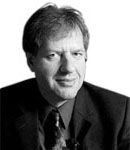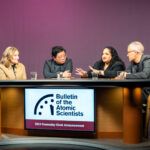An interview with Hugh Gusterson
By Hugh Gusterson | April 15, 2008
Describe life at Livermore.
I first moved to Livermore, a town of about 55,000, in the late 1980s to begin an anthropological study of Lawrence Livermore National Laboratory and its surroundings. Although San Francisco was an hour away, at that time, Livermore could best be described as a cultural backwater. Ethnic food was hard to find. The movie theater specialized in second runs. A small independent bookstore was struggling to survive and has since succumbed. The biggest event of the year was the Livermore rodeo.
Describe life at Livermore.
I first moved to Livermore, a town of about 55,000, in the late 1980s to begin an anthropological study of Lawrence Livermore National Laboratory and its surroundings. Although San Francisco was an hour away, at that time, Livermore could best be described as a cultural backwater. Ethnic food was hard to find. The movie theater specialized in second runs. A small independent bookstore was struggling to survive and has since succumbed. The biggest event of the year was the Livermore rodeo.
But even then, I found much to recommend. Livermore had good public schools, partly because so many local residents possessed PhDs. There were nice parks nearby, as well as vineyards, and lots of churches. The residents were friendly, having a strong sense that their community had a uniqueness that they didn't want to surrender to developers and malls.
Livermore has changed since then. Good ethnic food has come to town. The San Francisco Muni Metro line now comes close to Livermore. More vineyards have appeared, making the Livermore Valley a weekend wine-tasting destination. Thanks to the indefatigable Joan Seppala, who owns the Livermore Independent and has long pursued a maverick vision of Livermore as a sort of suburban cultural center simultaneously sheltered from plastic townhome development, a performing arts center is under construction. Livermore has also grown in size and become home to many who commute to work elsewhere in the Bay Area.
What ethical quandaries confront scientists who work for the national labs?
All scientists have a professional ethical responsibility to make sure that research isn't misrepresented, credit is properly assigned, and colleagues aren’t exploited. Scientists at the national labs are no exception. Beyond this, obviously, work on nuclear weapons raises special ethical questions.
The ethical landscape surrounding nuclear weapons work has shifted over time. The first generation of weapons scientists worked in an atmosphere of international emergency and felt that a nuclear war was quite possible. Some built bomb shelters in their backyards. Many also saw the Soviet Union as a profound threat to U.S. security and felt an obligation to prevent it from acquiring nuclear dominance. By the 1970s, the arms race had become a routinized sort of game. While it would be wrong for us to downplay the risks of catastrophe (especially given what we now know about some near misses from the work of Scott Sagan and Richard Rhodes's Arsenals of Folly), by the 1970s, many scientists felt more faith in the robustness of deterrence, and their ethical calculus shifted accordingly. This sense that the United States would surely never use nuclear weapons intensified with the Cold War's conclusion.
A weapons designer once told me he should feel no more responsible if the U.S. government used a nuclear weapon than a car designer should if a drunk driver killed someone. This remark brings us to the essential dilemma: On the one hand, the principle that the designers wouldn't be responsible for a political leader's decision to use the weapons could be seen as getting them off the moral hook; on the other hand, it's surely discomfiting to hand something as powerful as a nuclear weapon over to others and then have no control over its use. Where does responsibility end? In 1945, a small group of Manhattan Project scientists tried unsuccessfully to reach President Harry S. Truman to persuade him not to drop the Bomb on Japan. Years after Hiroshima, J. Robert Oppenheimer, who did play a role in picking Hiroshima as a target, told Truman he felt as if he had blood on his hands.
Name some public misperceptions about weapon scientists.
That they don't think about the ethics of their work. That they're all men–compared to the rest of physics, women are slightly overrepresented. That they love the military–the friction between loose-lipped, casual, intellectually exploratory physicists and buttoned-down military officers goes back to Oppenheimer and Gen. Leslie Groves, the military director of the Manhattan Project. That they're mostly conservative Republicans like Edward Teller.
How would you characterize the antinuclear weapons movement today?
Both stronger and weaker than when I began following this issue at the height of the Nuclear Freeze movement in the early 1980s. It's stronger because the terms of debate have largely shifted in its favor. In the early 1980s, the Nuclear Freeze movement's arguments for ending the arms race were dismissed as utopian. But now, nuclear testing and the mass production of nuclear weapons have ended. We have, more or less, a nuclear freeze, and the debate is now about whether nuclear proliferation can be avoided and nuclear weapons can be abolished. Nuclear abolition has even become a mainstream position given that former secretaries of state Henry Kissinger and George Shultz have advocated for it in the op-ed pages of the Wall Street Journal. (See "A World Free of Nuclear Weapons" and "Toward a Nuclear-Free World.")
On the other hand, the organizational strength of the antinuclear movement has atrophied. The U.S. and international publics have lost interest in nuclear weapons, and it's left to a small network of nongovernmental organizations near the nuclear weapon sites and in Washington to continue pressing for further disarmament.
Governments are always nervous about mass movements of impassioned citizens. And although a large antinuclear uprising seems unlikely now, the dedicated activists will keep the issue alive and will train a new generation of activists, until the next upsurge in public opinion. Or maybe the national security state will quietly make its own adjustments in response to this fascinating new group of elite conservative nuclear abolitionists, who, as far as I can tell, don’t talk to the old left abolitionists.
In what ways should anthropologists contribute to global security?
Anthropologists have debated this question at least since 1919 when Franz Boas, the founder of American anthropology, denounced four colleagues for using their status as anthropologists as cover for espionage activities during World War I. (Boas was censured for this by the American Anthropology Association–though the membership recently voted overwhelmingly to posthumously uncensure him.)
The issue of anthropological work for the national security state is a source of considerable controversy at the moment. Much of the debate has centered on Pentagon attempts to embed anthropologists in "Human Terrain Teams" in Iraq and Afghanistan. The American Anthropological Association has condemned anthropological participation in these teams and refuses to accept recruitment ads for them on the grounds that anthropologists have an overriding ethical obligation to not harm those they study. The association is also concerned that the small group of anthropologists working for Human Terrain Teams (often armed and in uniform) could cast a pall of suspicion on anthropologists everywhere, endangering their research and safety. A small minority of militarized anthropologists have openly rejected the association’s position. Others wish the association had gone further and rejected all secret research as incompatible with our discipline’s humane commitment to open communication.
My own feeling is that the association has to leave a space (whose exact parameters will be subject to intense debate) for individual ethical and political decisions: Some will refuse to contribute in any way to a war they see as unjust, while others might feel comfortable doing certain things–i.e., trainings on Islamic culture for troops about to deploy–but not others. But anthropologists have to be clear as a community that actions that potentially endanger our subjects and colleagues aren't a prerogative of individual choice. They are professionally unacceptable. The association was unquestionably right to put participation in Human Terrain Teams in this category.
My colleague Kevin Avruch draws a distinction between strategic and tactical levels of assistance to the national security state. It's a useful distinction. An example of strategic advice: If Secretary of State Condoleezza Rice had asked Middle Eastern anthropologists in 2002 what they thought would happen if Washington invaded Iraq. Strategic advice is what the national security state is least interested in getting from anthropologists, but where the ethical dilemmas for anthropologists are least intense. The national security state is most interested in milking anthropologists for tactical assistance–a form of work that can be hard to distinguish from spying on selected populations–and it's here that the ethical issues are most intense.
Evaluate the media coverage of proliferation issues.
The mainstream media's coverage of proliferation leaves a lot to be desired. First, it's mostly premised on the unspoken, highly questionable assumption that developing world nuclear weapons are more dangerous than Western nuclear weapons. Second, mainstream media coverage of proliferation is incessantly repetitive and, therefore, boring. Many of the articles on Iran repeat the same information over and over again, with some minor development used as a hook in the lead. Third, this coverage relies far too heavily on the recycled opinions of unnamed government sources and the same band of think tankers and former government officials. Fourth, foreign–especially developing world–opinions tend to be underrepresented. Articles about Iran's nuclear program quote U.S. and European sources condemning Tehran's nuclear work, but it would be nice to hear more opinions from Egyptians, Pakistanis, Russians, and Iranians.
Finally, the media has done a much better job telling the public about suspicions that Iran is seeking the Bomb than in reminding us that Iran has a right under Article IV of the Nuclear Non-Proliferation Treaty (NPT) to engage in the uranium enrichment programs they’re condemning. This may reflect a defect in the treaty, but it's an inconvenient truth that the public deserves to be reminded of.
Media coverage in recent years has improved in one respect. For many years, the U.S. media largely ignored developing world grievances that the established nuclear powers were ignoring their obligations to nuclear disarmament spelled out in Article VI. The media has done a better job reporting this side of the story at recent NPT Review Conferences.
Together, we make the world safer.
The Bulletin elevates expert voices above the noise. But as an independent nonprofit organization, our operations depend on the support of readers like you. Help us continue to deliver quality journalism that holds leaders accountable. Your support of our work at any level is important. In return, we promise our coverage will be understandable, influential, vigilant, solution-oriented, and fair-minded. Together we can make a difference.
Topics: Uncategorized















